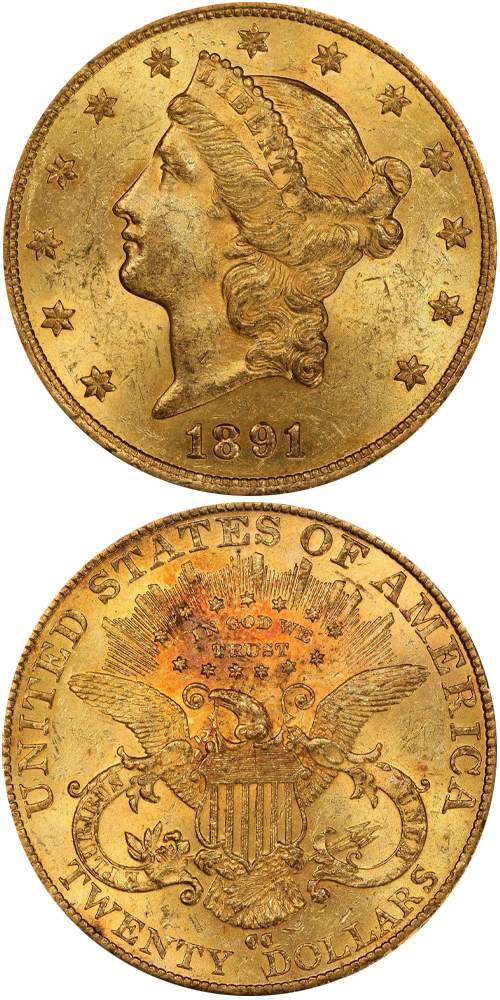1891-CC Liberty Head Double Eagle
Jeff Ambio: An evenly spaced, medium size date logotype that is placed just a bit low in the field identifies the only known obverse die of this low mintage CC-mint double eagle issue. On the only known reverse of the 1891-CC, the CC mintmark is tall, compact and offset to the viewer's right. The first C is right of center over the space between the words TWENTY and DOLLARS and the second C is nearly centered over the upright of the letter D in DOLLARS.
A heavily abraded issue that is usually also characterized by indifferent striking quality, the 1891-CC is one of the most challenging Carson City Mint gold coins of any denomination to locate with strong eye appeal.
Rusty Goe: Many, if not most, U.S. citizens in 1891 held strong views about the debate over the free coinage of silver versus the gold standard. The debtor-nation status of the United States, in many people's opinion, held the nation's economy in bondage to gold. An agrarian reformer A.J. Streeter said in 1889 "by narrowing the monetary base to gold and national bank notes, bankers gained control of the nation's currency supply." Silverite Adoniram J. Warner, a U.S. senator from Ohio, said, in 1893, that "the Secretaries of the Treasury, by giving the holders of these notes the right to demand gold, have made it possible for gold speculators to get gold from the Treasury ... easier than from any other source."
All throughout 1891, newspaper headlines shouted such announcements as "Gold Going to Berlin." This one, appearing in the Daily Alta of March 24, 1891, led to the journalist saying, "Gold is going now to Berlin, because it is worth more there than in any other part of the world."
President Harrison's administration and especially his Treasury Secretaries -- first William Windom (who died on January 29, 1891 while giving a speech to his national banker friends), and then Charles Foster who succeeded him -- tried to assuage the nation's fears as well. Yet, quietly, some said the administration was anti-silver, and that it would turn over the keys to the Treasury's gold to the "money power."
In and around Carson City, people were outraged about the so-called "Billion Dollar Congress" not including Nevada in on its extravagant spending spree. "Nevada, it will be observed, does not get a dollar," roared the Nevada State Journal on July 18, 1891. Of further aggravation, stated the Journal, "The appropriation made for the expenses of the Carson Mint were so small that the employees have to work for reduced wages, or quit." Coiner Colburn had not emitted a single $20 gold piece in the first half of 1891, as he concentrated on larger quantities of half eagles and eagles as well as a steady outturn of silver dollars. Sometime between July and December Colburn delivered five sacks (5,000 pieces) of double eagles, the lowest mintage of that denomination since year one — 1870.
Q. David Bowers: In 1891 there were only 5,000 double eagles struck at Carson City, of which I estimate about 175 to 250 survive in circulated grades, usually EF or AU, and a dozen or fewer in Mint State, my estimates being lower than those of Rusty Goe.
It seems likely that 1,000 or 2,000 were circulated locally and the rest exported. While it is numismatically fortunate that many double eagles (the most popular export denomination from 1850 onward) have survived to be repatriated, most were melted at their destinations. As an example the Bank of England melted double eagles and had the Royal Mint convert them to gold sovereigns.
The example to the left was sold by Stack's Bowers Galleries in the Fairmont Collection, JBR Set, where it realized $78,000.






